Ad libitum. And then?
16. Januar 2023 — General Information, Calf Feeding, Calf feeders — #weaning #Ad libitum #CalfExpert #Power supply #Calf Health #Calf feeder #GainsThere is much discussion about ad libitum feeding of calves. The advantages seem obvious: lots of milk yields lots of milk. This means that if I give the calves a large amount of milk to drink, it will have a positive effect on their milk production later on as cows. This effect is commonly referred to as metabolic programming.
Many farms also successfully apply this concept. Others do not cope so well, as they often report that weaning calves off the high amounts of milk is difficult. Calves do not consume enough concentrate or their growth slumps after weaning. On top of this come the high feed costs that intensive milk feeding entails.
The economic aspect can be quickly rebutted. If the feed costs are assessed on the basis of better growth, the costs per kilogram of body weight gain are often lower for intensively reared calves.
The other points of criticism, such as concentrate consumption or growth stagnation, were investigated by Isabelle Kuhn in her Master's thesis. We would like to present her findings in this article.
This article is about
"Effect of feeding duration and weaning procedure on behavioural traits and growth of rearing calves with ad-libitum feed intake"
Isabelle A. Kuhn, 2019
The study compared two groups of 40 female cow calves each.
The test group was fed ad libitum at the calf feeder until they were 35 days old. It was then slowly weaned from 12 to 2 litres per day over a period of 9 weeks. In other words, these calves were completely weaned by the time they were 14 weeks old.
The control group was also fed ad libitum at the calf feeder for 35 days. These calves were then continuously weaned from 12 to 2 litres per day over a period of 5 weeks. They were thus completely weaned off milk by the age of 10 weeks.
1. Energy intake and growth
The graph below shows that the calves start to eat more concentrate as soon as the amount of milk is reduced. However, it can also be seen that hardly any concentrate is eaten in the period prior to weaning - i.e. while the calves have ad libitum milk available. This confirms the negative observations made by some practitioners.
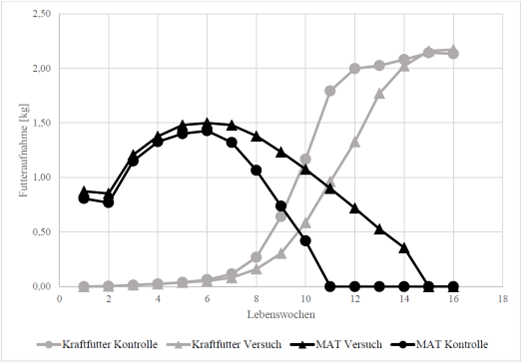
Observations made by Isabelle Kuhn during the weaning period are of interest, however. Here we note two periods: the period from day 36 to day 70 (blue) and the period from day 70 to day 98 (yellow).
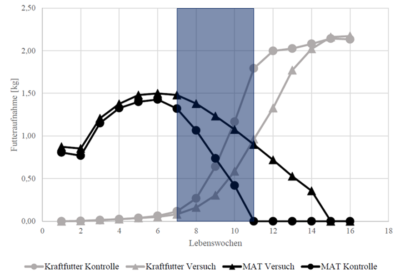
In the initial phase of weaning from day 36 to day 70 (in this phase the control calves were completely weaned from milk), the calves in the test group (slow weaning) showed higher daily gains than the control group (daily weight gain: 868.4 g vs. 770.3 g). The test animals had a significantly higher body weight of 80.7 kg compared to 77.7 kg at the end of this phase. This was partly because the total energy intake from CMR and concentrate was higher in the test group (27.6 MJ of metabolisable energy / day vs. 23.7 MJ of metabolisable energy / day).
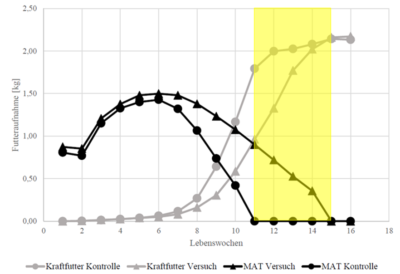
This trend continued into the second weaning phase from day 70 to day 98. The test calves had a higher daily weight gain (1,194 g vs. 1,046 g) with a higher average energy intake (29.2 MJ of metabolisable energy vs. 22.7 MJ of metabolisable energy). In the end, the body weight advantage was highly significant at 111.9 kg vs. 105 kg. At the end of the study (2 weeks after the final weaning of the test group), the test calves weighed 148.5 kg, while the control group weighed "only" 137 kg. (See Figure 2).
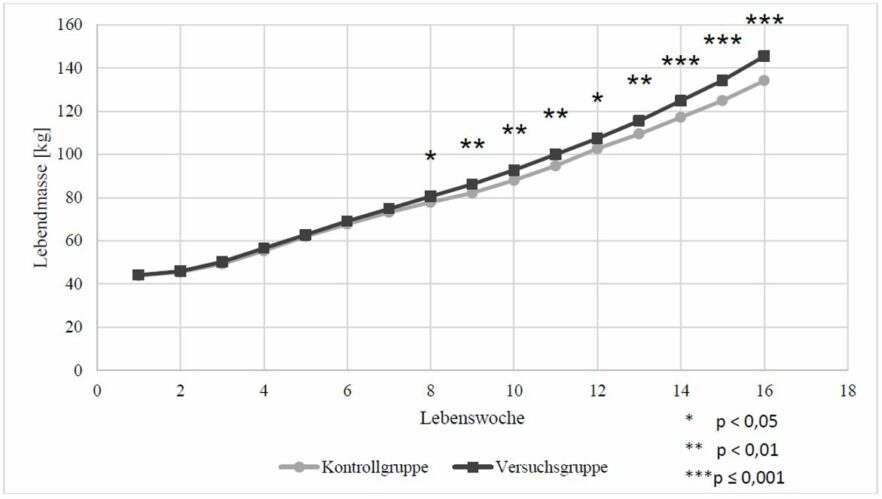
One interesting detail from the study is that the control calves (early weaning) consumed more kilograms of concentrate per kilogram of body weight over the entire weaning phase than the test calves (late weaning). However, they were unable to convert this advantage into greater growth because solid feed seems to be too poorly digestible at this stage. In contrast, the test calves benefited from the feed mix of milk and dry feed in the period after 10 weeks.
Other studies (DE PASSILLÉ, A. M. B. and RUSHEN, J. (2016)) have shown similar results. These authors were also able to demonstrate a significant variation in animal-specific adjustment in the digestion and ultimately also in the intake of concentrate feed by calves during the weaning phase.
Another interesting study by Eckert et al.compared weaning times of 6 and 8 weeks and could also see that the calves weaned earlier had lower daily weight gains than the calves weaned 2 weeks later. In contrast to the experiment by I. Kuhn described here, however, the calves were weaned with a step of 50 % in one week, so that they were not able to slowly accustom themselves to the intake of concentrate.
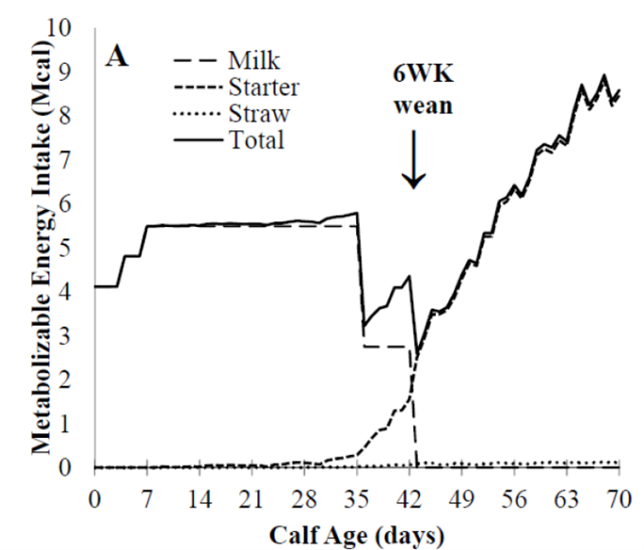
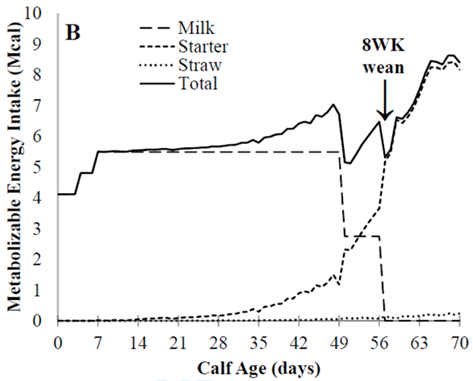
The energy curves above also show that the calves fall into an "energy hole" during and after weaning because the increasing intake of concentrate cannot compensate for the energy loss of milk. This deficit is significantly higher for the animals weaned at an early stage. This is also reflected in the body weight of the calves. Calves weaned early show a clear "growth kink" (Fig. 5)
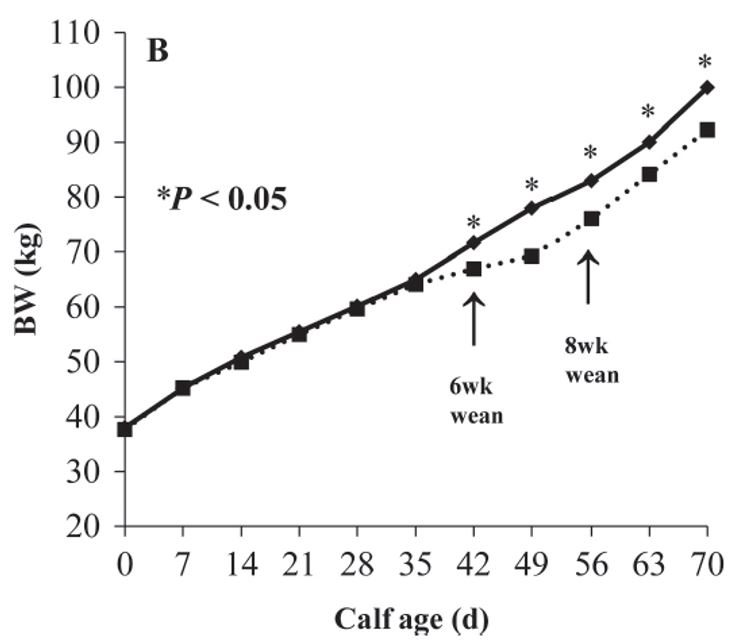
2. Calf behaviour
Isabelle also observed the behaviour of the calves during the different phases.
Rumination
She observed that the calves start chewing their cud as early as the 2nd week of life. Ruminating activity increased with age, but there was no difference between the two feeding schedules. If the low intake of concentrate up until weaning of the calves is also taken into account, the ruminating activity of the calves is no indicator of weaning maturity.
Behaviour when lying down
There was no difference in lying behaviour between the two groups. Even though other studies have shown that calves that are given less milk have higher activity rates, the difference seems to be primarily explained by the different ages of the calves. There seems to be a need for further research here.
Play behaviour
The widely held view is that calves that play feel at ease, which is why this aspect was also considered. In the study under review, however, there was no significant difference in the play behaviour of the calves between the two groups. It is therefore not possible to infer any difference between the two weaning programs with regard to calf well-being.
Behaviour at the feeder
It is generally believed that a high frequency of visits indicates a subliminal feeling of hunger in calves. In contrast, calves that rarely visit the feeding station seem to be sufficiently full.
In the current study, calves visited the stations an average of 5.7 times during the ad-libitum phase. The percentage of visits without credit was only 2 % due to the high amount of feed (12 litres per day). As expected, the proportion of visits "without credit" increased during weaning. Calves weaned earlier registered 6.9 visits "without credit" during the weaning phase, while calves weaned later registered only 5.8 visits "without credit".
This leads to the conclusion that the calves that were weaned late had a lower sensation of hunger than the calves that were weaned early.
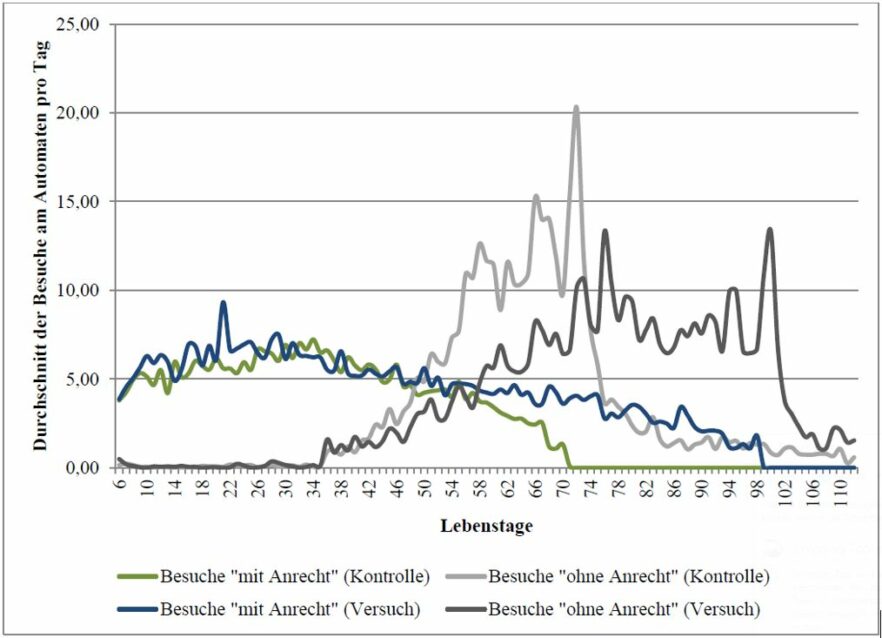
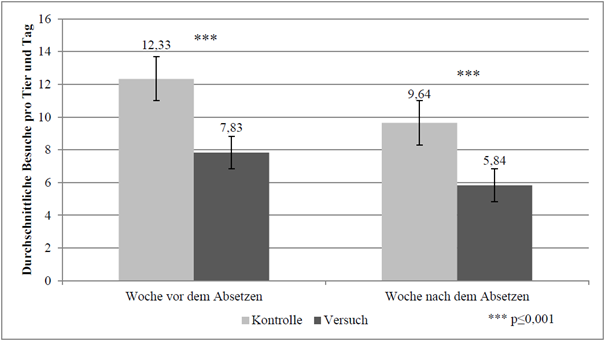
3. Conclusions
It can generally be assumed that a five-week ad-libitum phase followed by gradual weaning is positive for the development of the calves.
A prolonged weaning phase is preferable for the following reasons:
- Higher daily weight gain in the calves weaned later
- Better adjustment to the digestion of concentrate and better energy utilisation
- Avoidance of a growth kink after weaning
- Reduced sense of hunger in calves with a long weaning schedule and consequently assumed better animal welfare
Additional advantages that were not documented in the paper by Isabelle Kuhn, but which are supported by general knowledge regarding ad libitum feeding, are:
- Better calf health
- Earlier sexual maturity for insemination
- Lower age at first calving
- Lower rearing costs in raising heifers (these usually offset the higher feed costs of intensive milk feeding before first calving)
- Better lactation performance in the first lactation
- Longer life and higher lifetime performance
4. Implementation in practice using Holm & Laue products
The results of this study show that weaning calves slowly off milk at the CalfExpert calf feeder or using the SmartID function on the MilkTaxi is the ideal technical extension to ad-libitum feeding in the first few weeks of life. The benefits achieved in the metabolic programming of calves are sustained and, with good management, can be built on further.
However, farmers are not able to reduce the amount of milk on a daily basis in gradual, increments of a few 100 ml over a period of many weeks without technical assistance. Modern feeding technology supports this and also offers excellent opportunities for monitoring the behaviour of individual calves, even with large numbers of animals, thanks to individual analysis options on the calf feeder.
Holm & Laue's recommendation is therefore:
- Week: ad libitum colostrum feed
- until 4/5. Week: ad libitum whole milk or high-quality CMR with approx. 14-15 % DM
- until 12/14. Week of slow weaning at the CalfExpert feeder or using SmartID at the MilkTaxi
You can find out how to translate these recommendations into a practical feeding plan in the blog post “You are what you eat! – Nutrition planning for calves”.

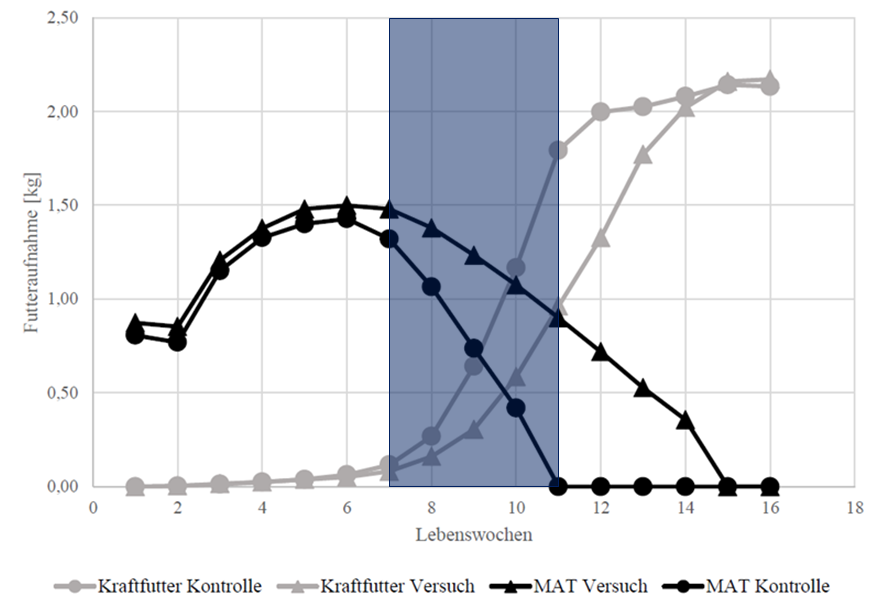
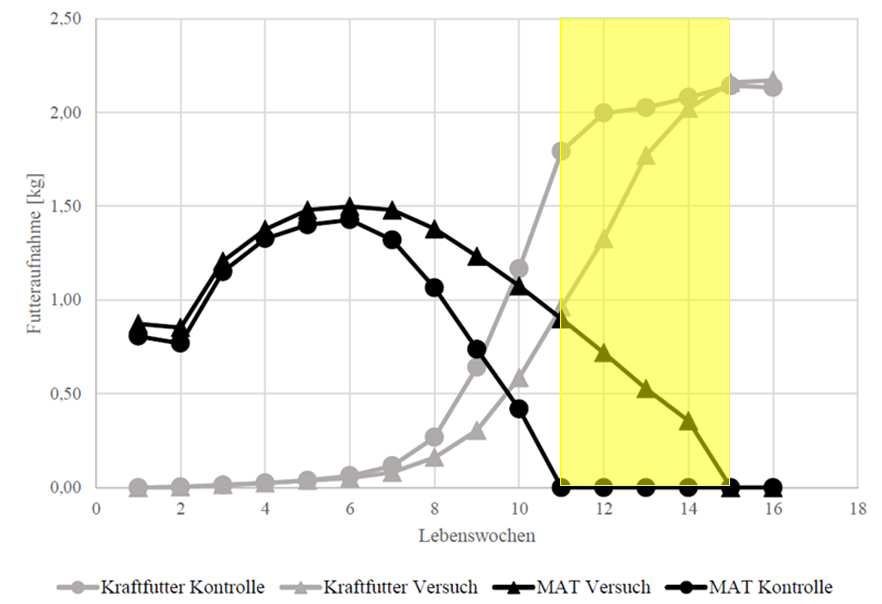
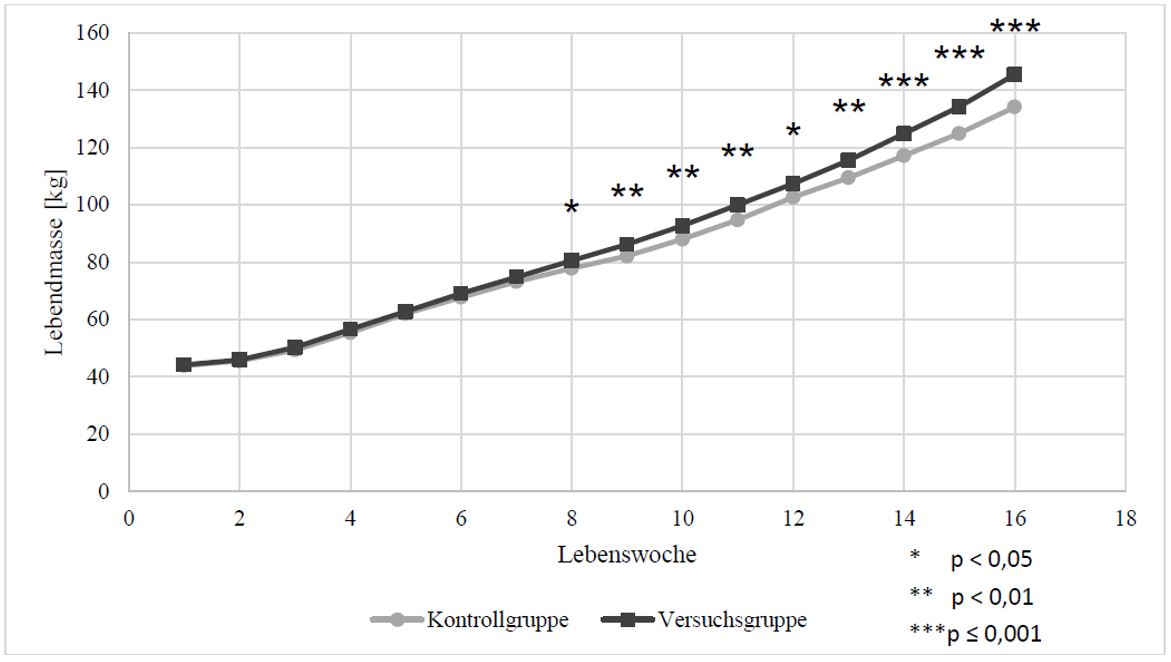 2. Live weight development of test animals
2. Live weight development of test animals
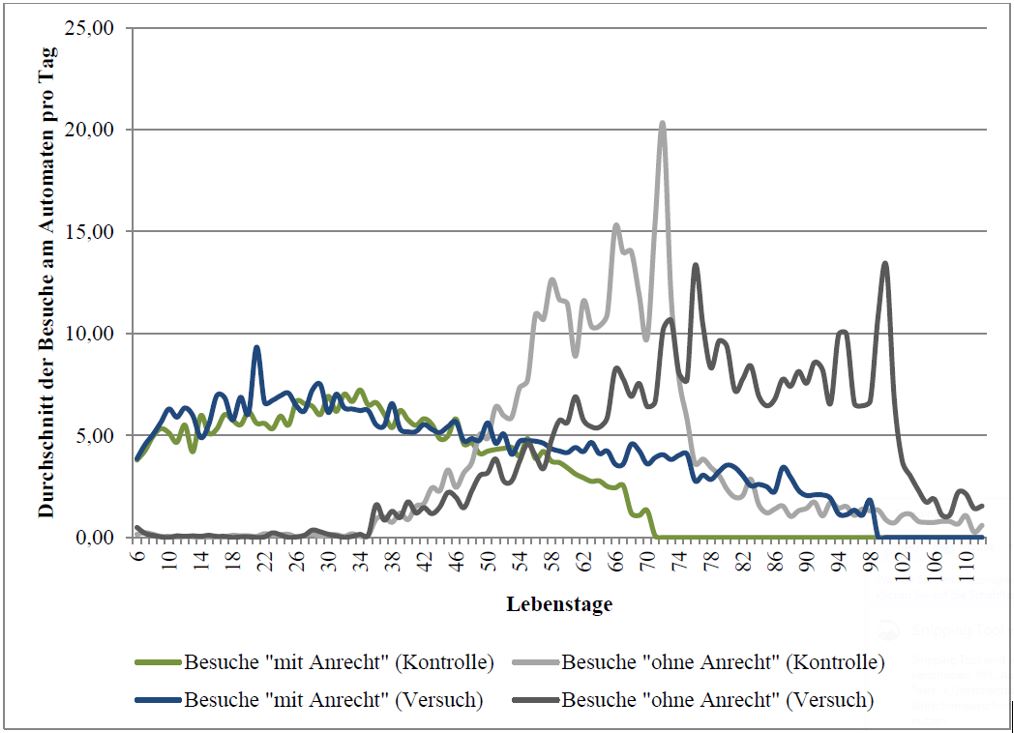 6. Visits of the calves to the feeder "with and without credit"
6. Visits of the calves to the feeder "with and without credit"